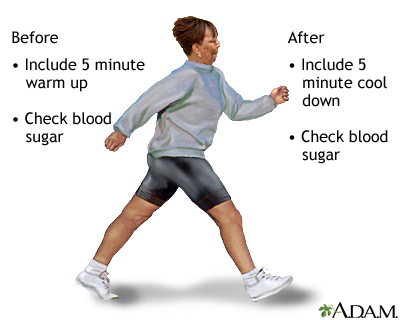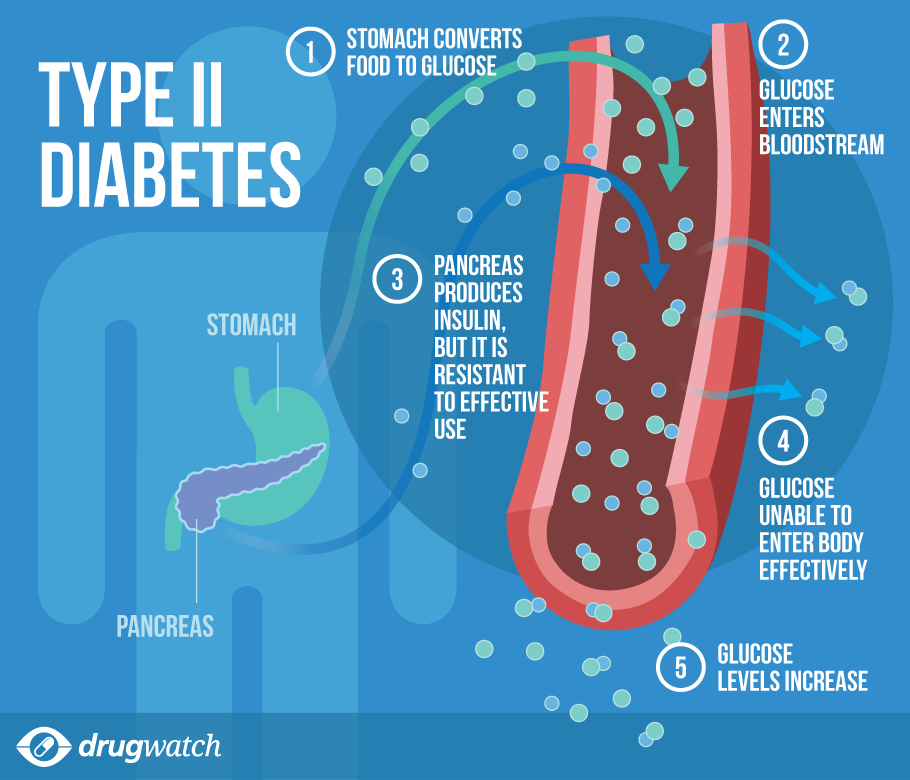Treatment for Type 1 Diabetes
Treatment for type 1 diabetes includes:
- Taking insulin
- Carbohydrate counting
- Frequent blood sugar monitoring
- Eating healthy foods
- Exercising regularly and maintaining a healthy weight
The goal is to keep the blood sugar level as close to normal as possible to delay or prevent complications. Although there are exceptions, generally, the goal is to keep blood sugar levels before meals between 70 and 130 mg/dL (3.9 to 7.2 mmol/L) and after meal numbers below 180 mg/dL (10 mmol/L) two hours after eating.
Other Medications
Additional medications also may be prescribed for people with type 1 diabetes, such as:
Pramlintide (Symlin) - An injection of this medication before eating can slow the movement of food through the stomach to curb the sharp increase in blood sugar that occurs after meals.
Cholesterol-lowering drugs - Cholesterol guidelines tend to be more aggressive for people with diabetes because of the elevated risk of heart disease. The American Diabetes Association recommends that:
- Low-Density Lipoprotein (LDL, or "bad") cholesterol to be below 100 mg/dL (2.6 mmol/L), and for individuals with heart disease, their LDL goal is to be below 70 mg/dL (1.8 mmol/L)
- High-Density Lipoprotein (HDL, or "good") cholesterol to be over 50 mg/dL (1.3 mmol/L) in women and over 40 mg/dL (1 mmol/L) in men. Triglycerides, another type of blood fat, are ideal when they're less than 150 mg/dL (1.7 mmol/L).
Treatment for Type 2 Diabetes
Medications in the form of tablets:
- Biguanide - prescribed to patients if a healthy diet and physical activity alone are not sufficient to help control the high blood glucose levels.
- Sulphonylureas - stimulates the cells in the pancreas to secrete more insulin, helping it to work more effectively within the body.
- Alpha glucosidase inhibitor (arcarbose) - used to slow down the intestine's absorption of starchy foods. This will slow down any rise in blood glucose levels after meals.
Prandial glucose regulators - has the same effect as sulphonylureas; stimulating the pancreas cells to secrete more insulin. This will take effect quicker but last shorter than sulphonylureas. It is advised to be consumed half an hour before a meal.
Thiazolidinediones (glitazones) - reduces insulin resistance and improves insulin sensitivity; leading to an increase in the effectiveness of insulin produced by the body. It also protects the cells in the pancreas. Thus, allowing the pancreas cells to produce insulin for a longer period of time.
Another way of managing type 2 diabetes is losing weight. It can be seen as a trend that many patients who are diagnosed with type 2 patients are overweight or obese. This is because the extra body fat in their body increases insulin resistance. Hence, by losing weight, patients are able to reduce insulin resistant in the body.
Weight loss can be done is various ways. The first approach would be to manage a healthy weight range through a healthy lifestyle that consists of a balanced diet with adequate exercise. However, often times, this may not be sufficient to help patients manage type 2 diabetes. Thus, weight loss surgery can be done. Medical research has shown that obesity surgery can directly affect how the body uses insulin. This form of treatment will directly benefit the patients in losing weight and regulating blood glucose levels. Moreover, it can help patients in better managing their type 2 diabetes through these few ways:
- Change the way hormones in the gut work. Thus, affecting how produces body makes insulin
- Increase the amount of bile acids that the body makes. Thus, causing the body cells to be more sensitive to insulin
- Improve the way the cells use insulin, leading to lower blood sugar levels.
Various forms of obesity surgery, also known as bariatric surgery, can be offered to type 2 diabetic patients. It can be the removal of a part of the stomach to reduce stomach size. Alternatively, a surgical re-route of the digestive system to bypass the stomach can be done. Both forms of surgery allow patients to reduce their food intake since they require less food to feel full.
Treatment for Other Types of Diabetes
Type 3 Diabetes - Medications
- Incretin mimetic drugs (like liraglutide (Victoza) and lixisenatide (Lyxumia)) - Are being studied to become possible treatments for type 3 diabetes as they have proved to potentially prevent the development of Alzheimer’s disease.
-
Pioglitazone (Actos) - A type of thiazolidinediones (insulin sensitizer) which increases the body’s sensitivity to insulin. It is also another medication that may help to prevent the development of Alzheimer’s disease.
Gestational Diabetes
-
Healthy diet
-
Eat regularly
-
Eat starchy and low glycaemic index foods - these foods releases sugar slowly
-
Eat Fruits and Vegetables
-
Avoid sugary foods and drinks
-
Regular physical activities and exercises so as to keep the blood glucose level under control.
-
Medications will be given if blood glucose level still does not decrease following healthy diet and regular exercises. Medications includes tablets and insulin injection.
-
Taking tablets such as Metformin or Glibenclamide.
-
Insulin injection will only be given if patient cannot take Metformin, if there are side effects with Metformin or when the blood glucose level is very high.
- Patients should also monitor their blood glucose level regularly using a finger-pricking device and putting a drop of blood on the testing strip.
References:
https://www.endocrineweb.com/conditions/type-2-diabetes/type-2-diabetes-how-lose-weight
https://www.diabetes.org.uk/Guide-to-diabetes/Managing-your-diabetes/Treating-your-diabetes/Weight-loss-surgery/
http://www.diabetes.co.uk/type3-diabetes.html
http://www.diabetes.co.uk/news/2014/jul/diabetes-drug-actos-associated-with-lower-rates-of-alzheimers-disease-91575976.html
http://www.nhs.uk/Conditions/gestational-diabetes/Pages/Treatment.aspx
Pioglitazone (Actos) - A type of thiazolidinediones (insulin sensitizer) which increases the body’s sensitivity to insulin. It is also another medication that may help to prevent the development of Alzheimer’s disease.
- Healthy diet
- Eat regularly
- Eat starchy and low glycaemic index foods - these foods releases sugar slowly
- Eat Fruits and Vegetables
- Avoid sugary foods and drinks
- Regular physical activities and exercises so as to keep the blood glucose level under control.
- Medications will be given if blood glucose level still does not decrease following healthy diet and regular exercises. Medications includes tablets and insulin injection.
- Taking tablets such as Metformin or Glibenclamide.
- Insulin injection will only be given if patient cannot take Metformin, if there are side effects with Metformin or when the blood glucose level is very high.
- Patients should also monitor their blood glucose level regularly using a finger-pricking device and putting a drop of blood on the testing strip.
https://www.diabetes.org.uk/Guide-to-diabetes/Managing-your-diabetes/Treating-your-diabetes/Weight-loss-surgery/
http://www.diabetes.co.uk/type3-diabetes.html
http://www.diabetes.co.uk/news/2014/jul/diabetes-drug-actos-associated-with-lower-rates-of-alzheimers-disease-91575976.html
http://www.nhs.uk/Conditions/gestational-diabetes/Pages/Treatment.aspx











